| Back in Chapter 14, I explained one good way to configure a mixed Wi-Fi and wired network using a combination Wi-Fi access point/router such as the Linksys Wireless Broadband Router or the Apple Extreme Base Station. What this amounted to was the simplest possible topology, namely plugging the wired part of the network into the access point/router as shown in Figure 16.7. Figure 16.7. The easiest way to set up a mixed Wi-Fi and wired network is to plug the wired devices into the Wi-Fi access point/router. 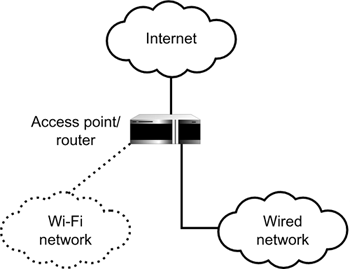
However, the topology shown in Figure 16.7 is not the only way to do things. As I showed you in Chapter 15, complicated networks can get pretty, well, complicated. One change to the topology shown in Figure 16.7 that sometimes makes a lot of sense is to use a standalone router for your network's routing and DHCP functionality, rather than using the Wi-Fi access point/router to do these things. A reason for this change might be if your standalone router had more sophisticated firewall capabilities than those built into the Wi-Fi access point/router. (For more about firewalls, see Chapter 19, "Securing Your Wi-Fi Network.") If you made this change, the Wi-Fi access point, whose router functions would no longer be used, would be plugged into the standalone router along with the wired portion of the network as shown in Figure 16.8. Figure 16.8. You might prefer to use a standalone router and plug your access point into it. 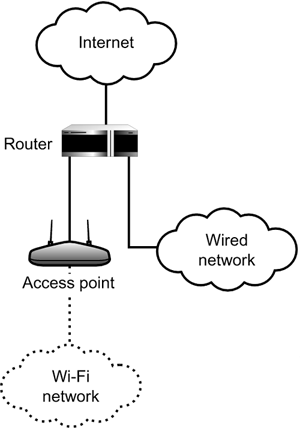
 | Quality standalone routers that include firewall capabilities are available from companies including D-Link, Linksys, and Netgear with a wide variety of prices. You can certainly buy one for as little as $30 or $40, but it is doubtful that a router at that price would have any very sophisticated firewall capabilities. |
If you'd like to use your access point/router as shown in Figure 16.8 just as an access point (and not as a router), you need to turn off its DHCP functionality. Figure 16.9 shows disabling the DHCP functionality of the Linksys Wireless Broadband Router using the DHCP tab of the device's administration panel. Figure 16.9. If you don't want to use an access point/router's routing functionality, you should set its DHCP server to Disabled. 
Click Apply to keep the change disabling DHCP. If you need to, you can go ahead and set up the SSID and encryption password for your Wi-Fi broadcast. Next, you can plug the Wi-Fi access point/router into your standalone router like any other device. caution  | With DHCP disabled, you may not be able to access the device's administration panel in the normal fashion by entering the appropriate IP in a Web browser. In fact, it may be necessary to use the reset switch on the device (which will re-enable DHCP) before you can access the administration panel again. |
To test the standalone Wi-Fi access point, from a Windows XP machine, you can check to see that it is shown as active in the Wireless Network Connection Properties dialog, as shown in Figure 16.10. Figure 16.10. The SSID of the access point is displayed as active in the Windows XP Wireless Network Connection Properties dialog. 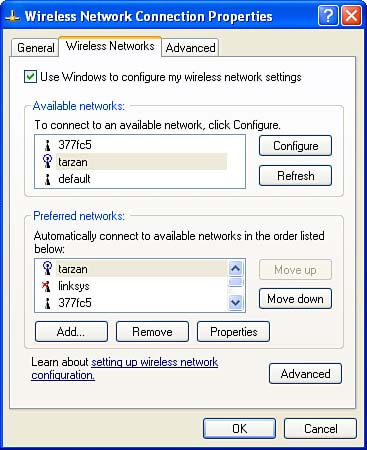
Assuming that you've entered the correct Network key in the Wireless network properties dialog, shown in Figure 16.11, you can check the connection status using the Wireless Network Connection Status window, shown in Figure 16.12. Figure 16.11. The Network key must be entered the way it appeared in the Wi-Fi access point. 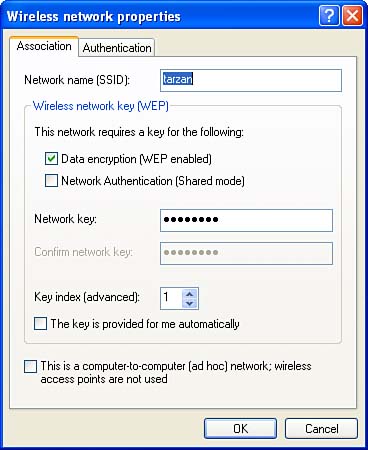
Figure 16.12. You can check the status of the standalone Wi-Fi connection using the Wireless Connection Status window. 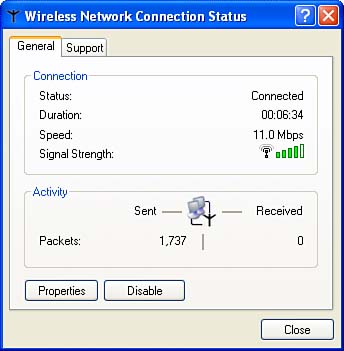
The Absolute Minimum Here are the key points to remember from this chapter: It's easy to share your Internet connection, and a very nice thing to do for ad-hoc Wi-Fi users. Dynamic IP addressing allows a variable IP to be used in place of a fixed IP, making the "bookkeeping" tasks involved in networks, and the Internet, much more manageable. A single IP address can be used to represent an entire local area network (LAN). If you want to use a standalone router, and plug your Wi-Fi access point into it, you should disable DHCP in the access point (if it provides this functionality).
|
|





